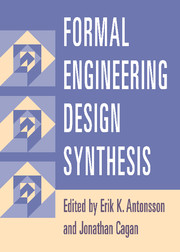Book contents
- Frontmatter
- Contents
- Contributing Authors
- Foreword
- Preface
- Introduction
- 1 Vitruvius Redux
- 2 How to Calculate with Shapes
- 3 Engineering Shape Grammars
- 4 Creating Structural Configurations
- 5 Microsystem Design Synthesis
- 6 Function-Based Synthesis Methods in Engineering Design
- 7 Artificial Intelligence for Design
- 8 Evolutionary and Adaptive Synthesis Methods
- 9 Kinematic Synthesis
- 10 Systematic Chemical Process Synthesis
- 11 Synthesis of Analog and Mixed-Signal Integrated Electronic Circuits
- 12 Mechanical Design Compilers
- 13 Scientific Discovery and Inventive Engineering Design
- Index
11 - Synthesis of Analog and Mixed-Signal Integrated Electronic Circuits
Published online by Cambridge University Press: 10 October 2009
- Frontmatter
- Contents
- Contributing Authors
- Foreword
- Preface
- Introduction
- 1 Vitruvius Redux
- 2 How to Calculate with Shapes
- 3 Engineering Shape Grammars
- 4 Creating Structural Configurations
- 5 Microsystem Design Synthesis
- 6 Function-Based Synthesis Methods in Engineering Design
- 7 Artificial Intelligence for Design
- 8 Evolutionary and Adaptive Synthesis Methods
- 9 Kinematic Synthesis
- 10 Systematic Chemical Process Synthesis
- 11 Synthesis of Analog and Mixed-Signal Integrated Electronic Circuits
- 12 Mechanical Design Compilers
- 13 Scientific Discovery and Inventive Engineering Design
- Index
Summary
INTRODUCTION
In today's microelectronics, and in particular the markets for so-called application-specific integrated circuits (ASICs) and high-volume custom ICs, demand is being driven by the increasing level of circuit integration. Today, we can build chips with 100 million transistors, yielding ten million useful logic gates. As a result, complete systems that previously occupied one or more printed circuit boards are being integrated on a few chips or even one single chip. Examples of these so-called system-on-chip (SoC) designs include single-chip digital television and single-chip cameras (ISSCC, 1996). New generations of telecommunication systems include analog, digital, and even radio-frequency (RF) sections on one chip. The technology of choice for these systems remains industry-standard complementary metal oxide semiconductors (CMOS), because of their unsurpassed scaling abilities; that is, when geometric feature sizes shrink with each new generation of CMOS technology, the resulting circuits and devices are not only smaller but also faster, and they consume less power. However, technologies that allow both CMOS and higher-speed bipolar transistors (e.g., BiCMOS, and more recently, embedded SiGe) are also used when needed for high-performance analog or RF circuits. Although most functions in these systems are implemented with digital circuitry, the analog circuits needed at the interface between the electronic system and the “real” world are also being integrated on the same chip for reasons of cost and performance.
- Type
- Chapter
- Information
- Formal Engineering Design Synthesis , pp. 391 - 427Publisher: Cambridge University PressPrint publication year: 2001



